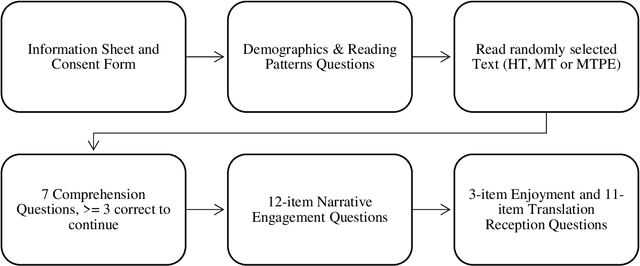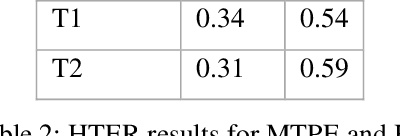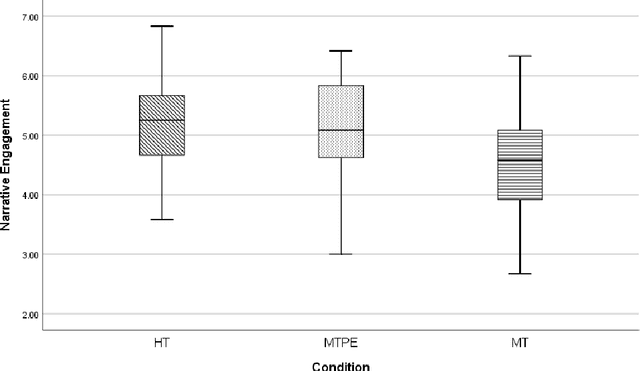Ana Guerberof Arenas
Optimising ChatGPT for creativity in literary translation: A case study from English into Dutch, Chinese, Catalan and Spanish
Apr 25, 2025Abstract:This study examines the variability of Chat-GPT machine translation (MT) outputs across six different configurations in four languages,with a focus on creativity in a literary text. We evaluate GPT translations in different text granularity levels, temperature settings and prompting strategies with a Creativity Score formula. We found that prompting ChatGPT with a minimal instruction yields the best creative translations, with "Translate the following text into [TG] creatively" at the temperature of 1.0 outperforming other configurations and DeepL in Spanish, Dutch, and Chinese. Nonetheless, ChatGPT consistently underperforms compared to human translation (HT).
To be or not to be: a translation reception study of a literary text translated into Dutch and Catalan using machine translation
Jul 05, 2023Abstract:This article presents the results of a study involving the reception of a fictional story by Kurt Vonnegut translated from English into Catalan and Dutch in three conditions: machine-translated (MT), post-edited (PE) and translated from scratch (HT). 223 participants were recruited who rated the reading conditions using three scales: Narrative Engagement, Enjoyment and Translation Reception. The results show that HT presented a higher engagement, enjoyment and translation reception in Catalan if compared to PE and MT. However, the Dutch readers show higher scores in PE than in both HT and MT, and the highest engagement and enjoyments scores are reported when reading the original English version. We hypothesize that when reading a fictional story in translation, not only the condition and the quality of the translations is key to understand its reception, but also the participants reading patterns, reading language, and, perhaps language status in their own societies.
DivEMT: Neural Machine Translation Post-Editing Effort Across Typologically Diverse Languages
May 24, 2022



Abstract:We introduce DivEMT, the first publicly available post-editing study of Neural Machine Translation (NMT) over a typologically diverse set of target languages. Using a strictly controlled setup, 18 professional translators were instructed to translate or post-edit the same set of English documents into Arabic, Dutch, Italian, Turkish, Ukrainian, and Vietnamese. During the process, their edits, keystrokes, editing times, pauses, and perceived effort were recorded, enabling an in-depth, cross-lingual evaluation of NMT quality and its post-editing process. Using this new dataset, we assess the impact on translation productivity of two state-of-the-art NMT systems, namely: Google Translate and the open-source multilingual model mBART50. We find that, while post-editing is consistently faster than translation from scratch, the magnitude of its contribution varies largely across systems and languages, ranging from doubled productivity in Dutch and Italian to marginal gains in Arabic, Turkish and Ukrainian, for some of the evaluated modalities. Moreover, the observed cross-language variability appears to partly reflect source-target relatedness and type of target morphology, while remaining hard to predict even based on state-of-the-art automatic MT quality metrics. We publicly release the complete dataset, including all collected behavioural data, to foster new research on the ability of state-of-the-art NMT systems to generate text in typologically diverse languages.
Creativity in translation: machine translation as a constraint for literary texts
Apr 12, 2022



Abstract:This article presents the results of a study involving the translation of a short story by Kurt Vonnegut from English to Catalan and Dutch using three modalities: machine-translation (MT), post-editing (PE) and translation without aid (HT). Our aim is to explore creativity, understood to involve novelty and acceptability, from a quantitative perspective. The results show that HT has the highest creativity score, followed by PE, and lastly, MT, and this is unanimous from all reviewers. A neural MT system trained on literary data does not currently have the necessary capabilities for a creative translation; it renders literal solutions to translation problems. More importantly, using MT to post-edit raw output constrains the creativity of translators, resulting in a poorer translation often not fit for publication, according to experts.
* 28 pages, 2 figures, 10 tables
The Impact of Post-editing and Machine Translation on Creativity and Reading Experience
Jan 15, 2021



Abstract:This article presents the results of a study involving the translation of a fictional story from English into Catalan in three modalities: machine-translated (MT), post-edited (MTPE) and translated without aid (HT). Each translation was analysed to evaluate its creativity. Subsequently, a cohort of 88 Catalan participants read the story in a randomly assigned modality and completed a survey. The results show that HT presented a higher creativity score if compared to MTPE and MT. HT also ranked higher in narrative engagement, and translation reception, while MTPE ranked marginally higher in enjoyment. HT and MTPE show no statistically significant differences in any category, whereas MT does in all variables tested. We conclude that creativity is highest when professional translators intervene in the process, especially when working without any aid. We hypothesize that creativity in translation could be the factor that enhances reading engagement and the reception of translated literary texts.
 Add to Chrome
Add to Chrome Add to Firefox
Add to Firefox Add to Edge
Add to Edge